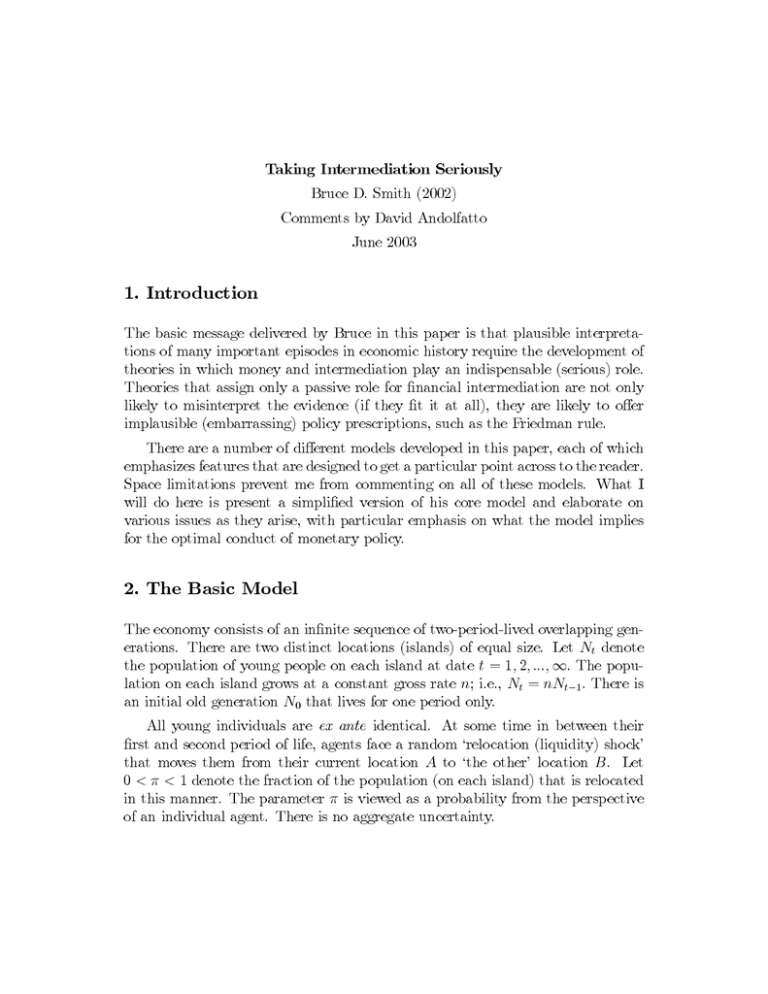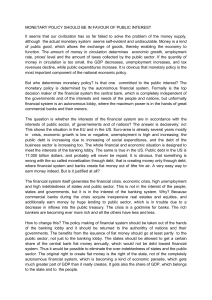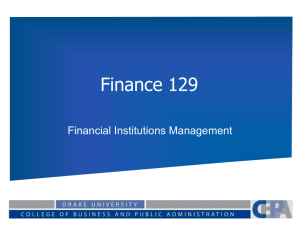Taking Intermediation Seriously
advertisement

Taking Intermediation Seriously Bruce D. Smith (2002) Comments by David Andolfatto June 2003 1. Introduction The basic message delivered by Bruce in this paper is that plausible interpretations of many important episodes in economic history require the development of theories in which money and intermediation play an indispensable (serious) role. Theories that assign only a passive role for financial intermediation are not only likely to misinterpret the evidence (if they fit it at all), they are likely to offer implausible (embarrassing) policy prescriptions, such as the Friedman rule. There are a number of different models developed in this paper, each of which emphasizes features that are designed to get a particular point across to the reader. Space limitations prevent me from commenting on all of these models. What I will do here is present a simplified version of his core model and elaborate on various issues as they arise, with particular emphasis on what the model implies for the optimal conduct of monetary policy. 2. The Basic Model The economy consists of an infinite sequence of two-period-lived overlapping generations. There are two distinct locations (islands) of equal size. Let N denote the population of young people on each island at date t = 1, 2, ..., ∞. The poput n; lation on each island grows at a constant gross rate i.e., an initial old generation 0 that lives for one period only. N N = nN −1. There is t t All young individuals are ex ante identical. At some time in between their first and second period of life, agents face a random ‘relocation (liquidity) shock’ that moves them from their current location to ‘the other’ location . Let A B 0 < π < 1 denote the fraction of the population (on each island) that is relocated in this manner. The parameter π is viewed as a probability from the perspective of an individual agent. There is no aggregate uncertainty. Let c i j denote the consumption of output by an individual in the i = A, B. j th period of life at location A representative young person values consumption only in the second period of life. Individual preferences are represented in the following way: U = (1 − π)u(cA2 ) + πu(cB2 ), (2.1) where u(.) is assumed to be strictly increasing and concave. Individuals have an endowment of output y > 0 when young. There is a linear storage technology that takes k units of current output and delivers xk units of future output. The capital investment k must be made before the realization of the relocation shock. If capital is ‘scrapped’ and moved to the other location, its return falls to εk, where n > ε > 0. Assume that x>n (so that the standard welfare-improving role for fiat money is not present). Now, consider the choice problem of a planner interested in maximizing the welfare of the representative young agent. The solution to this problem entails setting k y and cA2 cB2 xy. That is, the planner instructs each young person invest fully in capital and then play a game of ‘musical chairs;’ where relocating = = = agents acquire ownership in the capital that is left behind in each location. No capital is scrapped and agents enjoy perfect consumption insurance. Of course, in the absence of any restrictions to trade (in or across islands), the same outcome can be realized as a competitive equilibrium. 2.1. Limited Communication and Private Information In order to take money and intermediation seriously, Bruce introduces two key frictions. Following Townsend (1980), assume that young agents cannot communicate with ‘nonlocal’ or ‘foreign’ residents (agents living on the ‘other’ island). This assumption essentially prevents any interlocational trade from taking place through the use of privately-issued securities (thus opening the door for a fiat money instrument to facilitate such trade). Following Diamond and Dybvig (1983), assume that each person’s liquidity shock is private information. This assumption makes it impossible to write insurance contracts in which payoffs depend directly on the liquidity shock; this evidently precludes the operation of ‘simple’ competitive markets and allows for the emergence of an intermediary whose liabilities consist of demandable debt instruments.1 Together, these two ‘frictions’ will give rise to While private insurance contracts may not condition payoffs directly on private information, it is not immediately clear to me why incentive-compatible private insurance contracts could 1 2 an intermediary whose liabilities consist of debt instruments that are redeemable on demand for fiat money. The assets of the intermediary will consist of reserves of fiat money (to meet expected withdrawals) and loans to finance private capital expenditure. It is important to note that the balance sheet structure of Bruce’s intermediaries closely resembles that of actual banks. In the absence of money and banking, individuals are reduced to autarky; this allocation is given by: k = y; c2 = xy; c2 = εy. That is, the young simply invest A B all of their endowment and scrap their capital project in the event of relocation. The output loss (on each island) associated with the inefficient ‘scrapping’ and relocation of capital projects is given by: πN (x − ε)y. t 2.2. Money and Banking Recall that since x > n, the standard efficiency-enhancing role for fiat money is not present in this environment. But because of the limited communication friction, fiat money may nevertheless be valued for its superior ability to store value across locations (hence, allowing society to economize on the inefficient scrapping of capital projects). In other words, although fiat money is dominated in rate of return, it has the virtue of insuring agents against events that call for cash transactions. Let M denote the total stock of fiat money at date t and imagine that this fiat is issued by the government. Assume that the government grows the stock of money at some constant (gross) rate z and that new money (z − 1)M −1 is injected t t as a lump-sum transfer a to young agents at date t prior to the realization of the liquidity shock (also, assume that the initial old are in possession of the initial money stock). Let at date t so that: v t denote the value of money (i.e., the inverse of the price-level) N −1a = (z − 1)v M −1. t t t (2.2) Now, imagine the emergence of an intermediary that offers young agents a type of deposit/insurance contract. This contract calls for young individuals to deposit claims against their endowment y with the intermediary in exchange for a security that is redeemable on demand for cash. If the redemption option is not exercised, the security pays the competitive rate of return x. Let R > ε denote the (gross) rate of return on fiat; i.e., R vt+1 /vt . In this case, agents = not be written that condition payoffs on individual reports. 3 that experience the relocation shock will want to exercise the redemption option and carry their cash to the other location.2 Anticipating this, the intermediary must hold a sufficient amount of cash reserves q in order to meet the expected redemption activity (withdrawals). Free-entry into the business of intermediation will drive profits to zero so that a competitive intermediary behave in a manner that maximizes the expected utility of its representative depositor; i.e., maximize (2.1) subject to: ≤ ≤ ≤ q+k B (1 − π)cA 2 + πc2 B πc 2 y + a; xk + (2.3) Rq; Rq. If x > R (i.e., if the nominal interest rate is positive), then fiat is dominated in rate of return and the intermediary will try to economize as much as possible on cash reserves; i.e., the last constraint in (2.3) will be binding and the demand for fiat qD (R, a) is characterized by: xu x(y + a − q D ) (1 − π) = Ru RqD . π (2.4) What this condition tells us is that when the nominal interest rate is positive (x/R > 1), optimal bank behavior does not entail full insurance (those individuals making early withdrawals experience a lower consumption level). What this suggests is that, to the extent that a central bank can influence the equilibrium rate of return on money (or inflation), following the Friedman rule will allow individuals to insure perfectly against the risk of a liquidity (relocation) shock. But before investigating the nature of an optimal monetary policy, we must first characterize the general equilibrium for a given policy parameter z. 2.3. General Equilibrium The money market clearing condition is given by: vM =Nq , t t t D (2.5) for all t = 1, 2, ..., ∞. Consequently, the rate of return on money in a stationary equilibrium is given by 2 R = n/z. Now, from the government’s budget constraint We can make ε sufficiently small to ensure that R > ε in equilibrium. 4 (2.2), we have: a −1 = (z − 1) v M N ; = (z −z 1) q ( nz , a); t t t D R= n/z, together with the fact that Mt−1 = z −1 Mt . This latter expression implicitly where the last derivation has utilized the equilibrium conditions (2.5) and characterizes the equilibrium purchasing power of the monetary transfer as a function of the monetary policy parameter; i.e., a g z . Equilibrium consumption = () for those who experience the liquidity shock is therefore given by: c2 B ()≡ ( = = − 1 n D n q ( , a) ; π z z π −1 nz −1 q̂(z ); ( )) where q̂ z q D nz , g z . Equilibrium consumption for those not experiencing the liquidity shock is given by: cA 2 = (1 − π)−1x(y − z−1q̂(z)). If ε is sufficiently small, then the equilibrium of this economy features no inefficient scrapping of capital projects. Individuals who experience a liquidity shock simply make a withdrawal of money from the bank; this money earns a rate of return equal to n/z > ε. As such, society gains since when capital is scrapped it simply ‘evaporates.’ Nevertheless, the young do bear a cost in this monetary arrangement, since a portion of their resources y is now diverted to the old (who consume it). From a social point of view, this diversion of resources simply constitutes a redistribution of output. If scrapping projects is sufficiently costly (i.e., if ε is sufficiently small), then the young are willing to bear the redistributive consequences of the monetary arrangement. Notice that q̂(z)/y can be interpreted as the equilibrium ‘reserve-deposit’ ratio. As Bruce points out, this ratio appears to be inversely related to the nominal interest rate in the data. For the model here to be consistent with this observation, we require q̂ (z) < 0.3 Thus, low nominal interest rates imply that banks face low Bruce guarantees that this property will hold by making the appropriate restriction on preferences; i.e., see his Proposition 1 and footnote 18. 3 5 opportunity costs of holding cash reserves. Hence, their reserve holdings will be high. The good thing about this is that depositors are well-insured against liquidity shocks. But this insurance comes at a cost. In particular, the fact that bank reserves are high implies that their capital investments (lending to the private sector) are low. In this model, the level of real GDP is given by: Yt = which is an increasing function of y + nx (y − q̃(z)) N , t z as long as q̃ (z) < 0. Thus, according to Bruce, this model explains why low interest rate environments (like the Great Depression era U.S. and modern day Japan) are typically associated with prolonged recession. A few comments are in order. Note that in this model environment, there is a very tight link between monetary policy and the nominal interest rate. In particular, the nominal interest rate is determined by the Fisher relation, which depends on inflation, which in turn depends directly on the monetary policy parameter z. Decreasing z in the model leads individuals to revise downward their forecasts of inflation, which puts downward pressure on the nominal interest rate, leading to an increase in the demand for real money balances (cash reserves). The increase in the demand for real money balances increases the purchasing power of those who are initially holding cash balances. In the model, these individuals happen to be those with a very high propensity to consume (i.e., the old). Thus, resources are essentially diverted away from capital expenditure into consumption, leading to a decline in future output. Alternatively, one can just think of a lower inflation as implying a higher rate of return on money leading agents to substitute capital for money in their wealth portfolios. There are two things to be said about this. First, this is just a standard Mundell-Tobin effect that is present in many models that do not take intermediation ‘seriously.’ Second, the model would literally have us interpret the economic problems of modern day Japan as being rooted in an excessively tight monetary-fiscal policy regime that is keeping expectations of inflation very low. There may be something to this argument (although it is difficult to square with what many regard to be Japan’s very loose monetary and fiscal policies), but I think that there are other far more plausible explanations of Japan’s recent woes that have nothing to do with taking intermediation ‘seriously.’4 4 In particular, see Hayashi and Prescott (2002) and Andolfatto (2003). 6 2.4. Optimal Monetary Policy The idea that assets with similar risk characteristics should earn a similar rate of return is a compelling one. In the context of the present model (and many other models), money and capital are risk-free assets, so that equating the return on (non-interest bearing) money and capital is analogous to setting the nominal interest rate to zero; i.e., this is the celebrated Friedman rule. In Bruce’s model, following the Friedman rule has the virtue of insuring individuals fully against the prospect of liquidity shocks. On the other hand, the discussion above demonstrated how a low nominal interest rate encouraged banks to ‘hoard’ cash reserves instead of financing private capital expenditure. Does the Friedman rule continue to constitute optimal monetary policy in the current environment? In order to answer this question, let us construct to welfare function for a representative young person conditional on the monetary policy parameter z : ≡ x(y − q̃(z )) W (z) = (1 − π )u 1−π () 0 + πu nq̃π(z) , where q̃ z−1 q̂. Notice that q̃ z < . Differentiating this expression with respect to z yields: so that the optimal z ∗ must satisfy: x(y − q̃ (z xu 1−π Now, for an arbitrary ( ) = −xu (cA2 ) + nu (cB2 ) q̃ (z), W z ∗ )) = nu nq̃ (z π ∗ ) . (2.6) z, the equilibrium allocation is characterized by: xu x(y − q̃(z )) 1−π = n nq̃ (z ) u . z π (2.7) The only way to get (2.7) to correspond to (2.6) is for the monetary authority = 1; to set z ∗ i.e., hold the stock of money constant over time. In contrast, the Friedman rule dictates that z n/x < z ∗ . = What is the intuition behind the suboptimality of the Friedman rule in this environment? Recall that because x > n, the standard efficiency enhancing role of fiat money is not present; in a model without liquidity shocks, fiat is not valued unless it earns at least the rate of return on capital. In the standard OLG model, 7 the monetary authority could induce the young to hold both money and capital in their wealth portfolios by setting x = n/z, but doing so would entail a welfare loss for the representative young agent (i.e., an infinite number of future generations) as resources are transferred to the initial old. The optimal policy in this case (from the perspective of the representative young agent) is for money not to be valued. In the model developed by Bruce, however, fiat money may be valued by society not for its store of value properties, but for its ability to insure against events in which the use of private money instruments is prohibitively costly (e.g., paying for groceries at some foreign location with a check drawn on your local bank). Because fiat money is not valued (from a social perspective) for its ability to store value, the conventional intuition behind the Friedman rule does not apply. Fiat money is an inferior store of value but provides insurance against liquidity shocks. An optimal monetary policy must weigh these costs and benefits; when one does so, the Friedman rule does not emerge as the optimal policy. Finally, I should point out here that the suboptimality of the Friedman rule does not appear to hinge on the existence of banks. To see this, suppose that the liquidity shock is costlessly observable and verifiable. Then a competitive insurance market will deliver precisely the same allocation as in the banking arrangement above. This allocation will depend on monetary policy in precisely the same way as described above; evidently, one does not need to take banking ‘seriously’ in order to understand how the Friedman rule may fail to be optimal. 2.5. Fully Optimal Monetary Policy It may be worthwhile to note that the ‘optimal’ monetary policy described above was derived in the context of a central bank that was constrained to implement its policy through a single policy instrument (the growth rate of base money). In fact, the monetary authority should be able to do much better than this. Note that unlike private banks, the liabilities of the central bank are easily recognized and accepted for payments in all locations. A central bank should exploit this power in order to overcome the spatial separation and limited communication that inflicts private banks. There are at least three (equivalent) ways in which a central bank might do this. First, it could operate like a commercial bank, making collateralized loans to individuals. Second, it could engage in open market operations involving swaps of cash for private securities in order to meet the demand for liquidity. 8 Finally, it could open a discount window that discounted commercial paper. All three of these actions entail the issuance of government money that is fully backed by private securities: there would be no role for fiat money. In the context of Bruce’s model, a central bank operating in the manner described above would result in full investment (k = y) and full insurance (cA2 = cB2 = xy). However, from a political perspective, such a policy might be difficult to implement since there would be no way (in the model) to compensate the initial holders of government fiat (the initial old) for their loss of wealth. 3. Conclusions In this discussion, I have focussed on only a small part of Bruce’s paper. In particular, I have totally neglected his models of credit rationing and banking crises. Overall, his paper makes us think hard about the role of money and banking in determining the pattern of economic activity and sheds light on the type of monetary policies that are likely to help or hinder the process of economic development. Bruce concludes his paper with an intriguing set of items that remain on the research agenda. Thanks to Bruce’s pioneering efforts, our path to discovery has been made much easier. 9 References 1. Andolfatto, David (2003). “Monetary Implications of the Hayashi-Prescott Hypothesis for Japan,” working paper, Bank of Japan. 2. Diamond, Douglas W. and Philip H. Dybvig (1983). “Bank Runs, Deposit Insurance, and Liquidity,” Journal of Political Economy, 91(3): 401—419. 3. Hayashi, Fumio and Edward C. Prescott (2002). “The 1990s in Japan: A Lost Decade,” Review of Economic Dynamics, 5: 206—235. 4. Townsend, Robert M. (1980). “Models of Money with Spatially Separated Agents,” In Models of Monetary Economics, edited by J. Kareken and N. Wallace, Federal Reserve Bank of Minneapolis. 10







